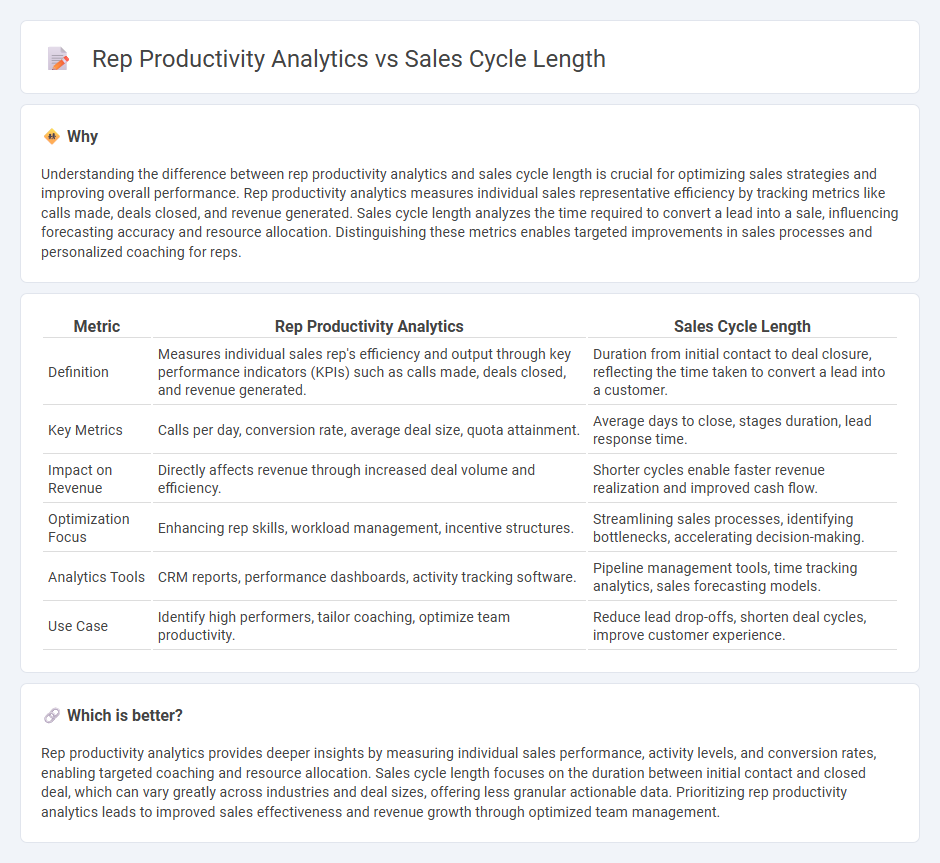
Sales rep productivity analytics measure individual performance metrics such as call volume, conversion rates, and revenue generated, providing actionable insights to optimize sales strategies. In contrast, sales cycle length focuses on the average time it takes to close a deal, highlighting potential bottlenecks in the sales process that affect overall efficiency. Explore how integrating these analytics can drive more effective sales performance and shorter cycle times.
Why it is important
Understanding the difference between rep productivity analytics and sales cycle length is crucial for optimizing sales strategies and improving overall performance. Rep productivity analytics measures individual sales representative efficiency by tracking metrics like calls made, deals closed, and revenue generated. Sales cycle length analyzes the time required to convert a lead into a sale, influencing forecasting accuracy and resource allocation. Distinguishing these metrics enables targeted improvements in sales processes and personalized coaching for reps.
Comparison Table
| Metric | Rep Productivity Analytics | Sales Cycle Length |
|---|---|---|
| Definition | Measures individual sales rep's efficiency and output through key performance indicators (KPIs) such as calls made, deals closed, and revenue generated. | Duration from initial contact to deal closure, reflecting the time taken to convert a lead into a customer. |
| Key Metrics | Calls per day, conversion rate, average deal size, quota attainment. | Average days to close, stages duration, lead response time. |
| Impact on Revenue | Directly affects revenue through increased deal volume and efficiency. | Shorter cycles enable faster revenue realization and improved cash flow. |
| Optimization Focus | Enhancing rep skills, workload management, incentive structures. | Streamlining sales processes, identifying bottlenecks, accelerating decision-making. |
| Analytics Tools | CRM reports, performance dashboards, activity tracking software. | Pipeline management tools, time tracking analytics, sales forecasting models. |
| Use Case | Identify high performers, tailor coaching, optimize team productivity. | Reduce lead drop-offs, shorten deal cycles, improve customer experience. |
Which is better?
Rep productivity analytics provides deeper insights by measuring individual sales performance, activity levels, and conversion rates, enabling targeted coaching and resource allocation. Sales cycle length focuses on the duration between initial contact and closed deal, which can vary greatly across industries and deal sizes, offering less granular actionable data. Prioritizing rep productivity analytics leads to improved sales effectiveness and revenue growth through optimized team management.
Connection
Sales rep productivity analytics measure individual performance metrics such as deal closure rates, call volume, and lead conversion times, which directly influence the sales cycle length by identifying process inefficiencies and bottlenecks. By analyzing these productivity insights, organizations can streamline strategies to shorten sales cycles, improve forecast accuracy, and enhance overall revenue generation. Optimizing sales representative activities based on data-driven analytics accelerates customer engagement and shortens the time from lead to close.
Key Terms
Average Sales Cycle Duration
Average Sales Cycle Duration directly impacts sales rep productivity by highlighting the time it takes to close deals, revealing efficiency bottlenecks. Analyzing these metrics allows businesses to identify stages causing delays and implement targeted strategies to shorten cycle length and boost revenue generation. Explore our detailed insights to master optimizing sales cycle duration and maximizing rep performance.
Conversion Rate per Sales Rep
Analyzing the sales cycle length alongside rep productivity reveals critical insights into the Conversion Rate per Sales Rep, highlighting efficiency differences across the sales team. Shorter sales cycles often correlate with higher conversion rates, indicating more effective engagement strategies by top-performing reps. Explore these analytics to optimize your sales process and boost overall team performance.
Sales Velocity
Sales velocity measures the speed at which deals move through the sales cycle, directly impacting rep productivity by identifying bottlenecks and optimizing time allocation. Shorter sales cycles typically correlate with higher sales velocity, enabling reps to close more deals in less time and increase overall revenue. Explore advanced analytics to unlock deeper insights into how sales cycle length influences rep productivity and drive strategic improvements.
Source and External Links
What Is Sales Cycle Length? Definition And Calculation - Kixie - The sales cycle length refers to the total time it takes for a potential customer to move through the stages of the sales process from initial contact to closing the deal, and it is calculated by averaging the duration prospects spend in each stage before completing a purchase.
Demystifying the 7 Stages of a Sales Cycle: A Complete Guide - Klenty - Sales cycle length varies by deal size, typically ranging from 1 week to a couple of months for startups, 3-6 months for mid-market deals, and 6 months to 2 years for enterprise deals, influenced by product complexity and decision-makers involved.
How to Calculate and Improve Average Sales Cycle - Mosaic - The average SaaS sales cycle is around 84 days and consists of multiple stages including prospecting, connecting, and qualifying leads, with timelines varying greatly by industry and product complexity.
 dowidth.com
dowidth.com